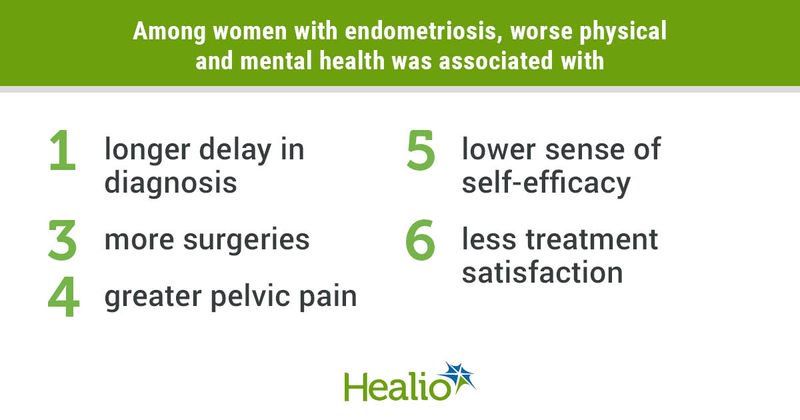Treating pelvic pain, psychosocial factors key in endometriosis care
Key takeaways:
- Physical and mental health were affected by endometriosis-related symptoms, treatment and care satisfaction.
- Pelvic pain and treatment satisfaction were most associated with physical and mental health scores.
Treating both pelvic pain and psychosocial factors is key to improving long-term physical and mental health outcomes for women with endometriosis, according to a longitudinal analysis published in Psychology & Health.
“The association between pelvic pain symptoms and health outcomes in endometriosis has been widely demonstrated, whereas psychosocial factors relevant to the treatment of endometriosis are still understudied,” Johanna Netzl, BA, doctorate student and research assistant in the department of psychology at the Free University of Berlin and the department of gynecology at the Endometriosis Centre Charité and the Center for Oncological Surgery at Charité – Berlin University Medicine, and colleagues wrote.

Netzl and colleagues conducted an online survey at the Endometriosis Centre Charité University Medicine, Berlin, and gathered data from 723 women (mean age, 30.6 years) with endometriosis from February to August 2021. In the survey, responders gave data on sociodemographics, endometriosis-related and psychosocial factors, physical health and mental health. Researchers reassessed physical and mental health for 216 participants who completed a follow-up questionnaire 3 months after the survey.
Average endometriosis diagnosis delay from first symptom onset was 9.11 years. Overall, 70% of participants reported noncyclical pelvic pain symptoms and 22% reported chronic pelvic pain.
Compared with the general U.S. population, participants in the survey reported physical health scores within the average range and reported mental health scores 1 standard deviation below the average at survey completion and reassessment.
In cross-sectional analyses, worse physical and mental health scores were associated with longer delay in endometriosis diagnosis, more surgeries, greater pelvic pain and a lower sense of coherence, self-efficacy, sexual satisfaction and gynecologic treatment satisfaction. Physical health scores were higher with fewer surgeries and monthly pelvic pain days, less pelvic pain intensity and greater sense of coherence, self-efficacy and gynecologic treatment satisfaction. Mental health scores were higher with lower endometriosis-related relationship strain and pelvic pain intensity, fewer monthly pelvic pain days and greater sense of coherence and gynecologic treatment satisfaction.
At reassessment, higher physical health was significantly associated with lower endometriosis-related relationship strain, pelvic pain intensity and overall pelvic pain, fewer monthly pelvic pain days and greater gynecologic treatment satisfaction. In addition, higher mental health was significantly associated with greater gynecologic treatment satisfaction.
“Future endometriosis research and care should strive for an interdisciplinary, biopsychosocial perspective to adequately meet the challenges posed by this complex disease and its consequences,” the researchers wrote.
